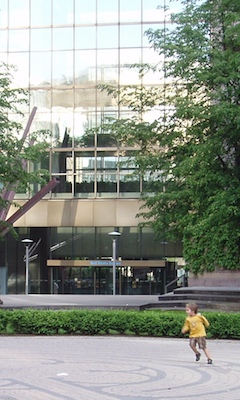From ARPANET to Internet
It is well known that the internet, that indispensable part of modern civilian life, started out as a US Department of Defence project to build a robust computer network, the ARPANET. I sometimes wonder what the military leaders of that era would think if they can see what their project has grown into. How would a general of the 1960s react to seeing people using this technology, designed for better warfare, to watch videos of cats doing wacky things?
In my mind I imagine that there was a fateful meeting that set the direction. In the 1960s, computer networks are emerging from research labs into productive applications, but they are not fault-tolerant. The military is interested, but the it needs networks that can survive attacks, and university labs think they have the answer. A meeting is convened at the Pentagon where university professors can present their ideas for a new kind of network.
The Professors have a Proposal
As a general and other military staff listen, the professors explain how networks of the day look like trees with branches, nodes, and leaves. This design is easy to build and run thanks to minimal links and simple route planning, but it has a problem: if any branch is cut then the network breaks into two parts.

… but any single failure breaks it.
The professors want to build a network that looks more like a highway system, where there are several routes between any two places. If a road is blocked, those multiple routes mean network remains largely intact.
Of course every benefit comes with a price, and with this road-map-style computer network the price is in the computers at the nodes of the network. When forwarding a packet of data toward its destination, a node has to choose between several outbound links. The choice depends not only on the direction to the destination, but on the capacity of each link and data-traffic congestion.
The computer in each nodes of the network requires more complex algorithms and more processing power than was current in the industry-standard tree-networks.
As the presentation progresses, the military staff are becoming more and more enthusiastic with what they are hearing, and by the end, they are sold on this project.
It is at this point a staff member stands up to say “Your proposal is very impressive, and I think I speak for all of us in saying we would like to move forward. What would be our the next step?”. The professors are ready with a plan to build a prototype network that links together several universities and military bases. The general asks, “Can you estimate how much your prototype network will cost?”. One professor stands up, and begins by listing a number of caveats – “great complexity”, “untested algorithms”, etc. – before finally stating a price. A very high price.
But How to Justify the Cost
There is a long and awkward silence. Finally the general stands up and speaks. “When the Department of Defence spends money, it is spending money that the taxpayers of the United States of America has entrusted to it, and so it is incumbent that every penny the Department spends is spent wisely and and is spent to obtain the best possible benefit for America. Your proposal is intriguing, but we are having some difficulty convincing ourselves that the potential benefits merit such a lofty price tag. Before we could agree to proceed, we would need to be able to justify this spending outlay to those whom we owe our allegiance, the People of America.”
Without missing a beat, one of the professors stands up and replies. “Yes, sir, we realize that, and that is why we see this technology paying off for both the military and the civilians of America. Today, America is full of cats that do wild and wacky things, and some owners of those cats make movies of them, but sadly they have no way to share those movies with the nation. We foresee a time when this technology will spin off from the military and blossom into resilient commercially-operated data networks; a time when ordinary Americans will connect to those networks; a time when people will use these networks to share their funny movies with the nation. This technology of the future will allow people all across America to post hilarious movies of cats getting stuck in boxes, cats landing badly after misjudged jumps, cats meowing in sync to music, cats …”
One of the military staff interrupts: “But I thought the future is supposed to bring civilians useful things like robots that will clean our houses.” “Yes,” the professor replies, “And when those robots arrive, someone will train his cat to ride around on one of those robots, and that person will want a place to show his cat for the nation to see.”
The Internet is Born, Thanks to Cats
The back-and-forth discussion continues, and slowly the professors win the military’s commitment to a vision of networks that span the nation, to serve both the mightiest war machine in the world and a civilian society enthralled by the likes of Maru and Keyboard Cat.
 Bonus Lesson (this part is real, folks)
Bonus Lesson (this part is real, folks)
When building a fault-tolerant network, you need to make sure the multiple, redundant links are really redundant. One day in 1986, seven different links in the ARPANET failed simultaneously, cutting the New England section of the network off from the rest of the United States. How could so many separate links fail all at once? After investigating, it was discovered those links weren’t really separate. The seven links were data lines leased from AT&T, and AT&T had multiplexed them all onto one fibre-optic cable, and that one cable had been cut.




